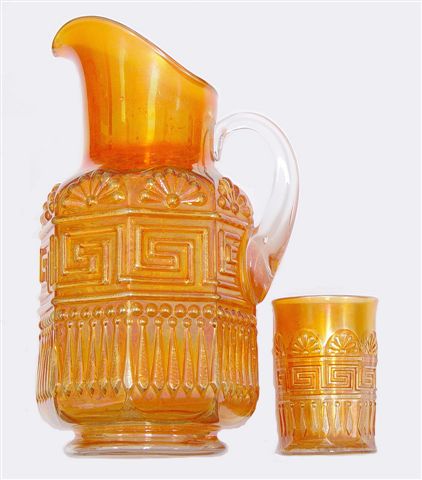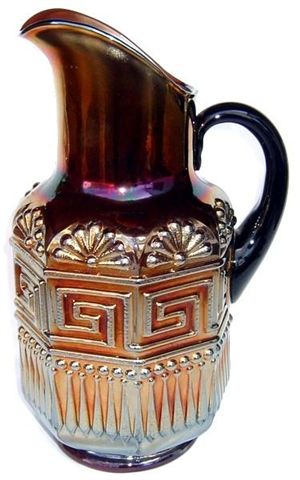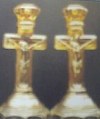Carnival Glass 101 | home Quick Reference to Carnival Glass Patterns on This Site
Northwood Water Sets - Part 3
NORTHWOOD WATER SETS - Part 3
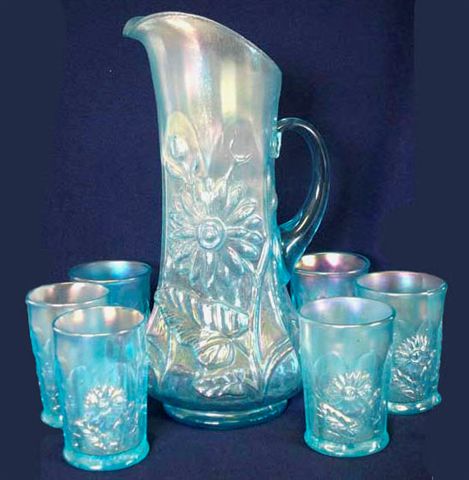 |
|
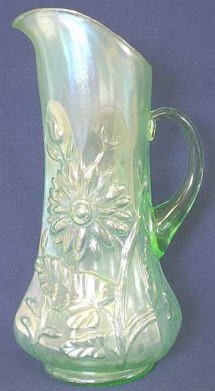 |
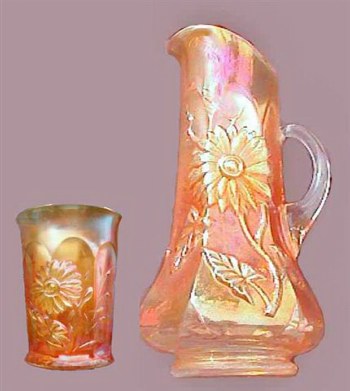 |
Only IG DANDELION Tankard known.
|
DANDELION in Marigold
|
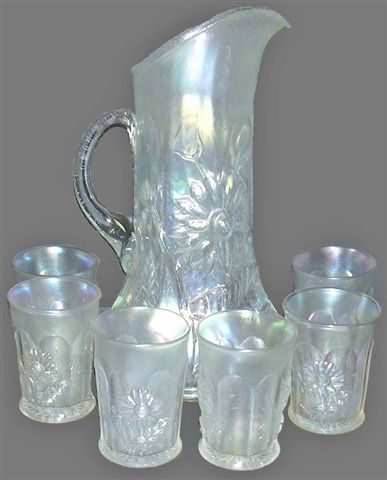 |
|
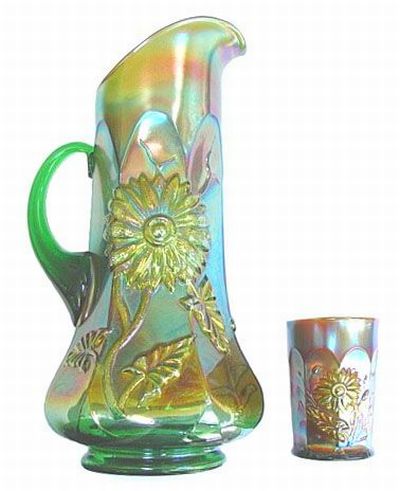 |
|
Northwood DANDELION in Green
|
|
DANDELION: Without question, this is one of the most handsome water sets known. The sleek overall shape commands the attention of most collectors. Why is it called Dandelion when the flower depicted is actually a Sunflower? Marion Hartung named it Dandelion when she wrote her now famous 10-volume series in the 1960s, and the name has followed through the years. Combined with the Oriental Poppy water set in a 1912 Butler Brothers Wholesale Catalog ad, the two sets have been considered “sisters”. Dandelion and Oriental Poppy are both mould-blown tankards having separately applied handles. They are not trademarked.
Water sets are found in marigold, amethyst, green-very scarce, cobalt blue-rare, white, ice blue, ice green-only one known, horehound. Tumblers have been reported in lavender and smoky/lavender/slag. Much more difficult to locate are tumblers having a ribbed interior. Amethyst, white, ice blue, ice green, lime green are colors known with that variation. Most tumblers have a plain interior.
You will note in the 1912 Ad that the set was marketed as Sunflower.
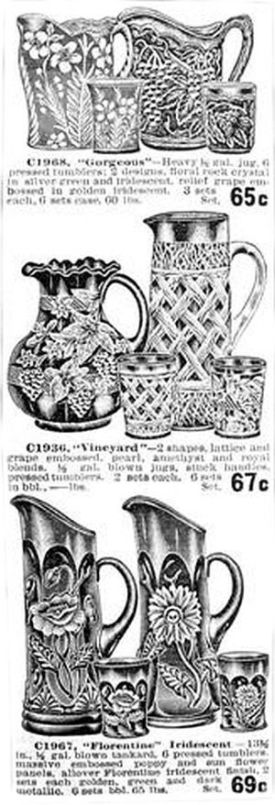
Spring 1912 Butler Bros. Wholesale Catalog ad displays
Imperial, Dugan and Northwood products within same ad
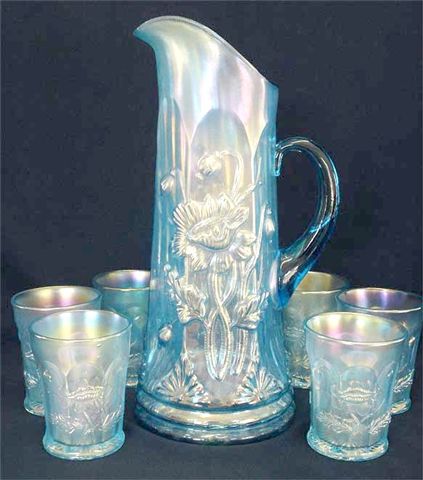 |
|
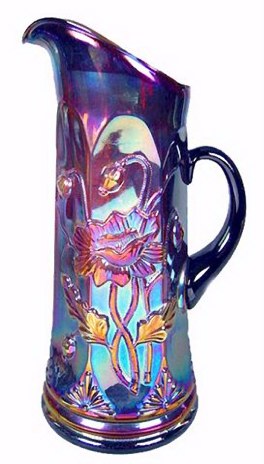 |
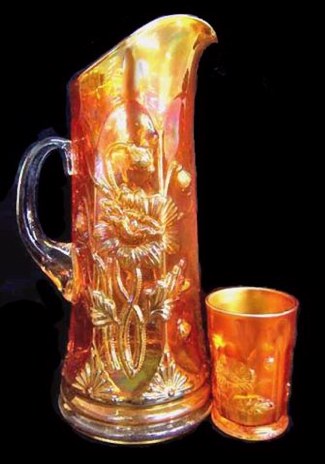 |
ORIENTAL POPPY - Amethyst
|
|
 |
|
ORIENTAL POPPY - Green
|
|
ORIENTAL POPPY: 1911-1912 was the prime period of patterns blossoming for competition in the carnival glass market. In 1991, a large 11” marigold ruffled bowl surfaced and was identified as Oriental Poppy. It actually is an iridized example of Northwood's Intaglio Poppy design; a carry-over from the non-iridized Intaglio line of 1908.
Listed colors in order of availability: marigold, amethyst, green, cobalt blue, white, ice blue, ice green tankards. Tumblers are usually found in the same order, with the addition of lime green.
UPDATE: Oriental Poppy Tankard/Tumbler - 8/10/2010
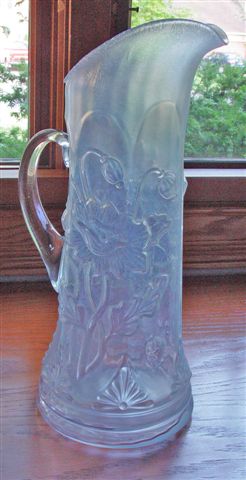
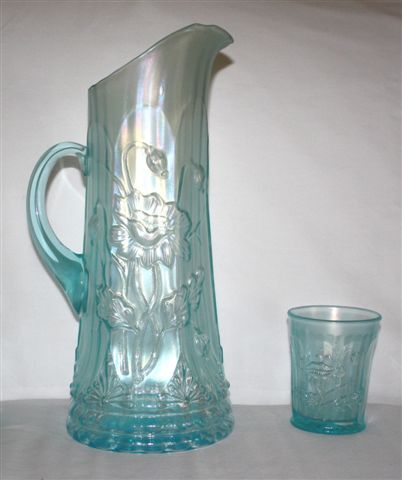
Left - Displays perpendicular lines left from interior mold when glass was blown against outer mold.
Right - Ice Blue ORIENTAL POPPY courtesy Jerry & Carol Curtis.
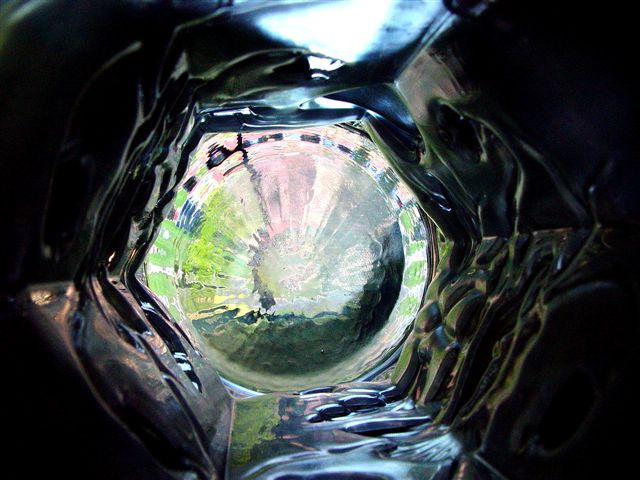
Inner hexagon shape showing ribs emanating from center bottom.
This photo of the Ice Blue set was received today, noting that one of the authors of carnival glass books mentions a “variant” in this water set, indicating that some of the pastel examples exhibit perpendicular lines (or ribbing) on the inside. This feature is not noticed on the darker colored sets.
We shall attempt to explain the reason for this mistaken assumption. As you look directly down into the tankard, an obvious hexagonal shape can be seen. This explains the obvious six panels which comprise the outer design. Within each of those panels on the interior can be seen/felt, a ribbed design.
There was a mold with those definitive perpendicular lines (or ribbing) on it. On the end of the pontil there is hot glass. The glass blower blows a bubble inside the glass. After that, he puts it into the mold, blows it again to put a bubble inside the glass. Now he has the configuration of those perpendicular (24) lines on the glass. Now, it goes back to the glory hole and the bubble is cased with more glass—enough to complete the tankard. He takes it over into the true mold with the Poppy design on it and he blows the shape of the tankard. The amount of glass used in the process was not “measured”, so the force of the blowing makes some variation in the thickness of the glass, as well. Result of this, makes the ribbing more distinct in some examples than in others.
The resultant ribbing originates from the center bottom, emanating up the sides of the tankard/tumbler as the blowing process is accomplished. (You will note the lined effect in the photo showing the inner hexagon shape looking down to the bottom of the tankard. All ribbing emanates from that central point.) That mold would have been more or less cone-shaped having 24 ribs.
Production of tumblers and pitchers/tankards were separate; placed together into sets at the time of shipping. (This is the reason so many tumblers do not “match” as a set. Each “turn” (a half-turn=200, a full-turn=400) was iridized at different points in time and perhaps by a different person. The reason some tumblers in this Oriental Poppy pattern do not have the visible ribbing: sometimes that inner mold was not used for “effect”?
The lines are not noticeable on amethyst, green, marigold, etc. examples because the base glass color, combined with the overlay of iridescence covers them up. The lighter pastel shades are not so heavily iridized. Therefore, the lines (ribs) become more noticeable.
When these factors are given substantial consideration, we do not believe they constitute a “variant” status. Carl O. Burns makes no mention of such in his 2001 Northwood Carnival Glass book. He has spent a lifetime dealing with all kinds of carnival glass and his Mother before him also dealt in the glass, so Carl’s background of study and learning is extensive.
In many cases, auctioneers, collectors and authors would do well to consider the manufacturing process ahead of resorting to the “variant” attribution.
Dean & Diane Fry
GREEK KEY: Both collar-based and dome-footed bowls, 8”-9” in diameter and 9” plates are found in this interesting pattern, but perhaps the most eagerly sought and extremely treasured of shapes within the design are the water sets. The mould-blown tankards with separately applied handles are impressive sights. These sets do not present themselves very often. Only produced in marigold, amethyst and green, even the marigold will present a challenge to locate! While the tumblers usually bear the  trademark, the tankards do not.
trademark, the tankards do not.
Dean & Diane Fry 11/08
      |
|
My son, if you receive my words, and treasure my commands within
you, so that you incline your ear to wisdom, and apply your heart to
understanding; yes, if you cry out for discernment, and lift up your
voice for understanding, if you seek her as silver, and search for her
as for hidden treasures, then you will understand the fear of the Lord,
and find the knowledge of God.
For the Lord gives wisdom; from His mouth come knowledge and
understanding; He stores up sound wisdom for the upright; He is a
shield to those who walk uprightly; He guards the paths of justice, and
preserves the way of His saints. Then you will understand
righteousness and justice, equity and every good path.
~~~~~ (Proverbs 2:1-9)
|
|
      |
Should you care to contact the Frys, their email address is:
Search Carnival Glass 101
back to Carnival Glass 101
Our other sites you may enjoy:
Everything you EVER wanted to know about Indiana Glass
Great Reference for Newer Carnival Glass.
Complete Glassware Catalogs Available to Download
Questions? Comments? Suggestions? Broken Links? Corrections?
Your Friendly Webmaster is here to help!
